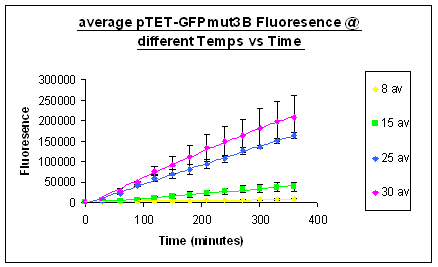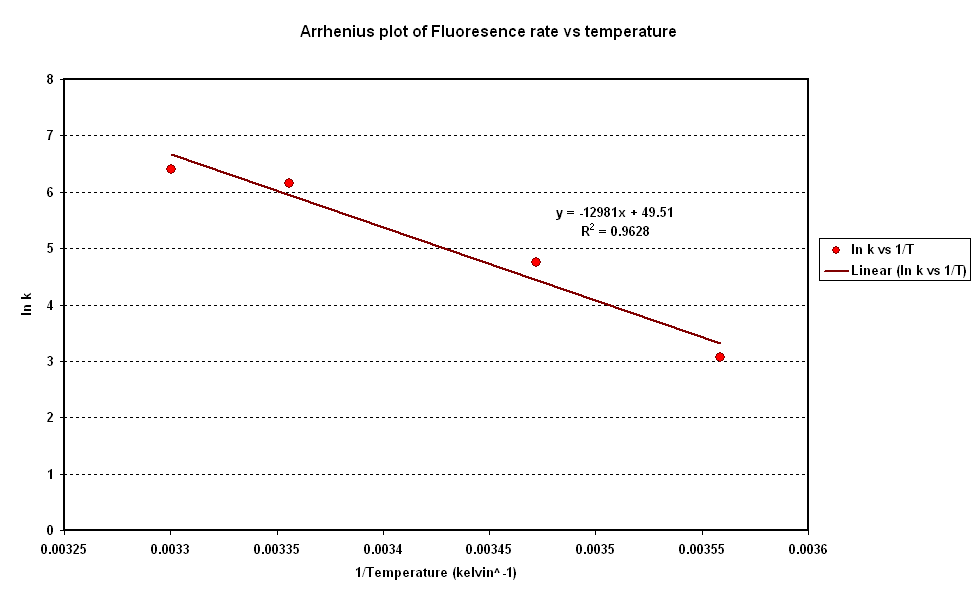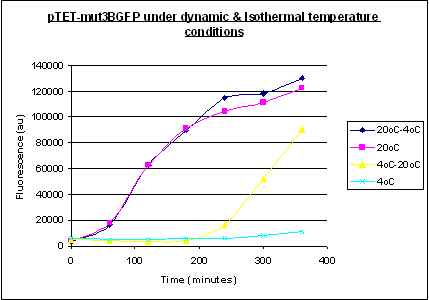Imperial/Cell by Date/Testing
From 2007.igem.org
m (→Investigation properties of system under isothermal scenarios) |
m (→Investigation System properties under Dynamic Temperature Conditions) |
||
| Line 18: | Line 18: | ||
| - | + | asdf | |
==Validation and Conclusion== | ==Validation and Conclusion== | ||
Revision as of 14:06, 22 October 2007

Testing and Discussion
Investigation properties of system under isothermal scenarios
In order to investigate the properties of our system we began by looking at isothermal scenarios in order to determine primarily the activation energy of our sytem following Giannuzzi's work with beef. Again this is useful because as per Taoukis' research for a TTI to function correctly its activation energy needs to be close to the target product. In Figure 1 above we see that under isothermal conditions a steady rate of fluoresence was observed, corresponding to a steady rate of protein production. This rate increase with temperature as per our predictions as protein production is linked to the kinetics of translation and so temperature. We have been able to extract the rate of protein production for range of temperature and made an arrhenius plot to further explore translation kinetics. A strong linear correlation in the log plot seems to suggest that an arrhenius type dependance on temperature seems to fit the translation mechanism. From this we have been able to calculate the activation energy as 1.5kJ/mol.
In addtion to calculating the activation energy through these experiments we have also been able to determine the operating range of our system. Our system seems to 'turn off' at around 4 degrees C. At 8 degrees with have minimal expression which then increases to a substantial expression at 37 degrees. Unfortunetly we have not been able to use a visible reporter and so have no idea whether the construct can in fact produce a visible signal. In terms of lifespan we have had major problems with evaporation.
Investigation System properties under Dynamic Temperature Conditions
asdf
Validation and Conclusion
| Inputs | ||
| Outputs | ||
| Activation Energy | ||
| Health Regulations | ||
| Response Time | ||
| Lifespan |
Previous work has been carried out to model the spoilage of ground beef by living organisms.
Above in figure 1 is is a model developed by Koutsoumanis in 2006 which colesly fit the behaviour of the spoilge organism we are interested in, Pseudomonas, under dynamic temperature conditions. One of the Key conclusions drawn from this model is the almost instantaneous repsone time of the Pseudomonas' growth parameter. The result of this is that our system needs to have a quick respone time to correclty report the temperature history of the beef.
Koutsoumanis' and also one Giannuzzi developed in 1998 are both based on the Gompertz model. This model allows some insight into the mechanisms of ground beef spoilage. In particular through manipulation of the Gompertz Parameters and assuming a Arrhenius type relationship between Pseudomonas' growth parameter and temperature we can infer the Activation energy of the spoilage reaction. This is shown in figure 2 in which a stongly linear behaviour allows us to continue with our Arrhenius assumption and extract that Activatoin energy of the spoilge reaction. As given in our specifications the Activation energy for ground meat seem to be around 30kJ/mol. The result of this as per Taoukis' work is that our system needs to have a similar activation energy. I hope to determine our system activation energy in the same way Giannuzzi determined Pseudomonas'.


